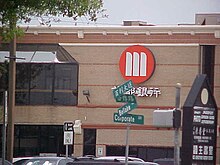Bellaire Boulevard


Bellaire Boulevard (also known as Holcombe, and as 百利大道 Bǎilì Dàdào in Chinese and Đại Lộ Sàigòn in Vietnamese[1]) is an arterial road in western Houston, Texas, United States. The street also goes through unincorporated areas in Harris County and the cities of Bellaire, Southside Place, and West University Place.
Bellaire Boulevard goes through or next to the Houston communities of Alief, Chinatown, Gulfton, and Sharpstown.[2] In addition the boulevard goes through the Greater Sharpstown management district.[3] John Nova Lomax of the Houston Press described Bellaire Boulevard as "a world market of a street, a bazaar where Mexicans, Anglos, Salvadorans, African Americans, Hondurans, stoners, Vietnamese, Chinese, Filipinos, Japanese, Koreans and Thais go to shop and eat."[2] The street ends at Holcombe Boulevard, which extends to the Texas Medical Center.[4]
As of 2005 many Salvadoran immigrants live and work along the portion of Bellaire Boulevard in the Gulfton area.[5] Many Asian American businesses populate the sections of Bellaire Boulevard in Alief and Chinatown.[6]
From west to east, the east segment begins at FM 723 in Richmond and concludes at Edloe Street in Southside Place where it changes into Holcombe Blvd. It is 16.7 miles long.[7] The western segment is 6.2 miles long, beginning (from east to west) at Harlem Road in Richmond and concluding at FM 723 where it becomes Fulshear-Gaston Road. The two segments together run for 22.9 miles.[8] A proposed extension would combine the two segments into one.[9]
History
[edit]William Wright Baldwin, who was the president of the South End Land Company in the 1900s and 1910s, constructed the portion of Bellaire Boulevard from the Bellaire town site to Main Street in Houston.[10] He also incorporated the Westmoreland Railroad Company to build an electric streetcar line down the centre of the boulevard. The streetcar, known as the "Toonerville Trolley," operated from December 12, 1910, until bus service replaced it on September 26, 1927.[11]
See also
[edit]References
[edit]- ^ Jacques Kyagilo (December 12, 2019). "image by jacqueskyagilo for Mapillary". Mapillary. Retrieved January 20, 2019.
- ^ a b Lomax, John Nova. I am a Pedestrian Report: Bellaire Archived July 20, 2008, at the Wayback Machine. Houston Press. May 25, 2007. Retrieved on August 4, 2009.
- ^ "Districts Archived 2009-01-06 at the Wayback Machine." Greater Sharpstown. Retrieved on January 24, 2010.
- ^ Kever, Jeannie."STREET HISTORY Who was Stella Link?." (Archive). Houston Chronicle. January 25, 2008. Retrieved on January 24, 2010.
- ^ Moreno, Jenalia. "Salvadoran émigrés build a new life and a commerce network in Houston by providing products and services familiar to their fellow countrymen / A foreign concept." Houston Chronicle. Sunday, February 6, 2005. Business 1. Retrieved on January 24, 2010.
- ^ "Super Neighborhood #25 - Alief Archived August 17, 2009, at the Wayback Machine." City of Houston. Retrieved on January 24, 2010.
- ^ "Bellaire Blvd (East Segment)". Google Maps. Retrieved July 18, 2020.
- ^ "Bellaire Blvd (West Segment)". Google Maps. Retrieved July 18, 2020.
- ^ "2019 MTFP Map.pdf" (PDF).
- ^ Bellaire, Texas from the Handbook of Texas Online. Retrieved on January 24, 2010.
- ^ The Beautiful City of Bellaire, Texas Archived July 5, 2011, at the Wayback Machine City of Bellaire, Texas Website.
